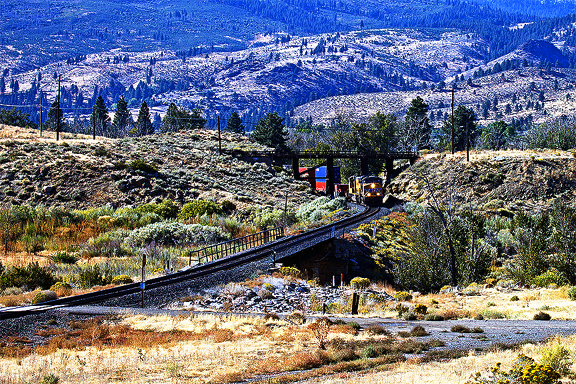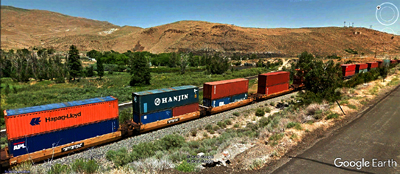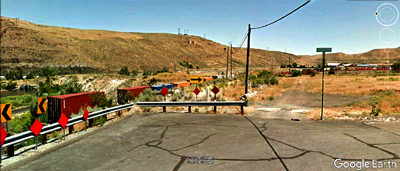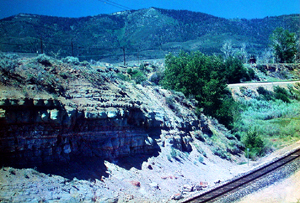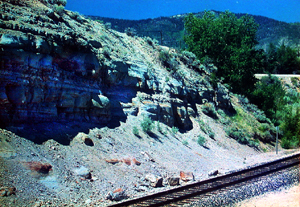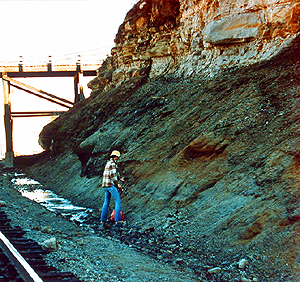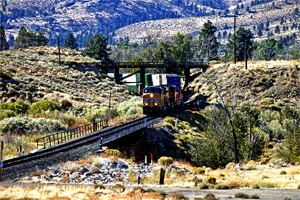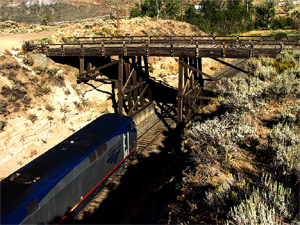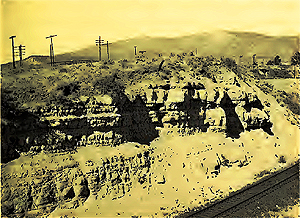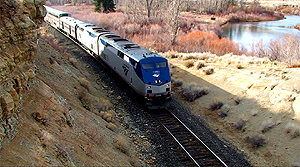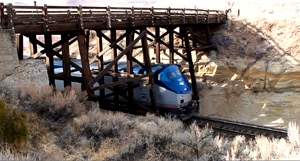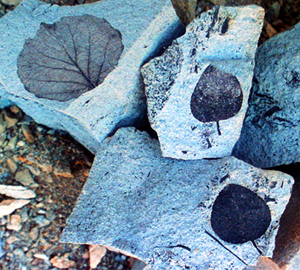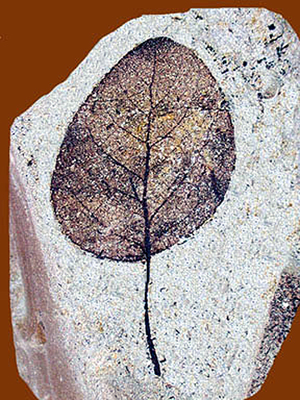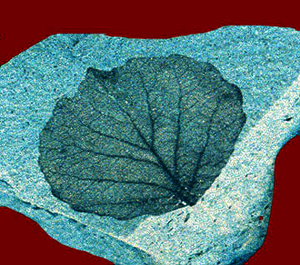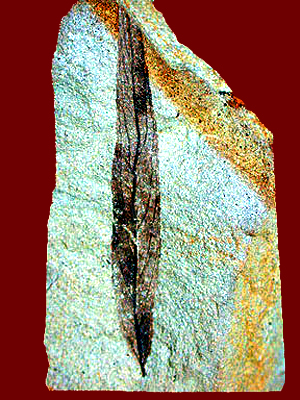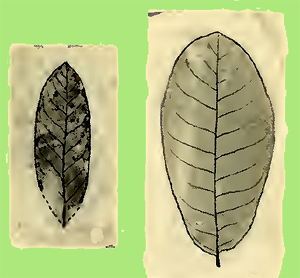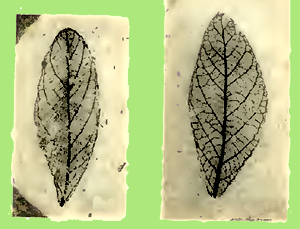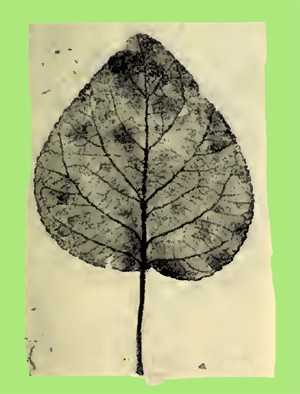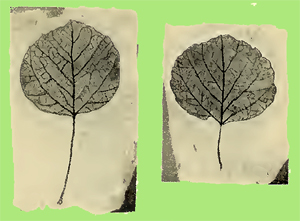|
Yosemite, Kings Canyon, Mount Whitney-each is an awesome
example of nature's handiwork amidst the grandeur of California's
central to southern Sierra Nevada. Yet, some six to five million
years ago that mighty mountain range revealed far less precipitous
extremes, and the great alpine altitudes so spectacular today
there were in their youthful stages of development. At that early
period of Sierran geomorphological creation, sluggish rivers
wandered through extensive floodplains in a region of only moderate
topographic relief; lakes and stagnant ponds lay scattered in
the basins, and thickets of riparian vegetation associated with
elevations dramatically lower than present grew along the watercourses.
Proof of this radically different scene can be found in
rocks exposed near Verdi, Washoe County, Nevada, on the eastern
slopes of the Sierra. Here occurs a wonderful fossil leaf locality
in a sequence of sedimentary beds dated by sophisticated geophysical
radiometric techniques at 5.8 million years old, a site where
the numerous species of plants preserved provide a direct link
with the climate and geography of the geologic past.
Verdi is a small gaming community that lies along Interstate
80 approximately 10 miles west of Reno, Nevada. The leaf-bearing
beds occur in the vicinity of town along a railroad cut in what
stratigraphers have assigned to the uppermost (youngest) layers
of the upper Miocene Hunter Creek Sandstone.
This railroad cut exposes a 28-foot thick section of the
Hunter Creek Sandstone, presently considered 5.8 million years
old through accurate radioactive isotope analyses. The exposure
extends in an east-west direction for a minimum of 125 feet and
fossil leaves can be found throughout it--primarily in the bluish
to gray andesitic sandstones that were derived during late Miocene
times from an older volcanic formation, the Kate Peak Andesite.
Interbedded with the sandstones are minor lenses of tan to white
diatomaceous shales (composed mainly of diatoms, a microscopic
photosynthesizing single-celled algae), within which occur nicely
preserved leaves of a species of pond weed, referred to scientifically
as Potamogeton verdiana--named specifically for its special
occurrence here in the Hunter Creek Sandstone near Verdi.
The history of fossil plant collecting at Verdi goes back
to the 19th Century. In his 1878 report regarding the famous
Fortieth Parallel Survey--an exploratory expedition mandated
by the US Congress, conducted from northeastern California through
Nevada to eastern Wyoming during 1867 to 1872--geologist Clarence
King (first Director of the United States Geological Survey)
first mentions the occurrence of fossil plants near Verdi, Nevada.
In 1909, in a report about oil and gas potential in the Reno
region, R. A. Anderson provides a brief but detailed examination
of leaf-bearing beds in the vicinity of Verdi, from what Clarence
King had previously called the Truckee Formation (a geologic
rock unit whose paleobotanical preservations are now understood
to occur in the newly named Hunter Creek Sandstone). On page
483 of that same paper, Anderson also describes a "near
Reno" fossil leaf collection secured from probable Truckee
Formation beds by a professor J. P. Smith, who kept the specimens
at Stanford University; taxa preliminarily identified included
birch, serviceberry, manzanita, willow, and a pine cone. Some
five years later, around 1914, a H. S. Gale submitted a small
collection of Verdi area leaves to the US National Museum, but
apparently published no formal documentation of the occurrence;
sad, that--because, as later paleobotanists have noted, Gale
found several species that have never since been observed from
what's now called the Hunter Creek Sandstone. In 1916, vertebrate
paleontologist J. C. Merriam used information supplied by paleobotanist
F. H. Knowlton to help establish what Merriam believed, at that
date, was a geologic correlation between Clarence King's Truckee
Formation and the bone-bearing Esmeralda Formation in Nevada--a
paleontologically rich deposit presently known to contain middle
to early late Miocene faunas approximately 16 to 10 million years
old; Knowlton compared a collection of Verdi vicinity leaves
with plants already sampled from the Esmeralda Formation and
concluded (quite erroneously, of course) that the two floras
could be considered contemporaneous. Not until the early 1920s
did a professional paleobotanist--that would be R. W. Chaney--finally
amass the first large collections of fossil leaves from the Verdi
locality. Supplemental collecting expeditions to Verdi by the
late paleobotanist Daniel I. Axelrod in 1939, 1947, 1953, 1954,
and 1956 increased the number of fossil specimens exponentially.
In 1977, David A. Orson, a graduate student at the University
Nevada, Reno, extracted pollen grains from lignite beds exposed
in the upper half of what's now called the upper Miocene Hunter
Creek Sandstone, Verdi Basin, Washoe County, Nevada, but his
palynological specimens, recovered through maticulous dissolution
of the low grade coal matrix with potently hazardous acids (among
them, hydrofluoric acid--one of the most powerful acids known
to exist--which is frequently used to break down rocks suspected
to contain microscopic pollens) did not come from the Verdi fossil
leaf locality.
All told, seekers of fossil leaves have recovered 18 species
of plants from the Verdi exposures of upper Miocene Hunter Creek
Sandstone. The most abundant leaves found belong to a Miocene
variety of black cottonwood, Populus alexanderi--called
affectionately by paleobotanists the "common Pliocene cottonwood."
Also present are the leaves of Miocene analogs of Scouler's willow
(Salix boisiensis), Goodding's black willow (Salix
truckeana), quaking aspen (Populus pliotremuloides),
Korean aspen (Populus subwashoensis), pinemat manzanita
(Arctostaphylos verdiana), valley oak (Quercus prelobata),
Engelmann oak (Quercus renoana), interior live oak (Quercus
wislizenoides), sierra gooseberry (Ribes galeana),
buckbrush (Ceanothus precuneatus); and a bitter cherry
(Prunus moragensis). All of these leaf specimens occur
exclusively in the sandstone strata, along with the needles,
cones, and cone scales of such conifers as white fir (Abies
concoloroides), ponderosa pine (Pinus florrisanti),
sugar pine (Pinus prelambertiana), and Knobcone pine (Pinus
pretubercula). In addition to yielding the slender leaves
of pond weeds (Potamogeton verdiana), the lenticular seams
of whitish diatomaceous shales also contain the remains of water
lilies (Nymphaeites nevadensis) and stonewarts (Chara
verdiana).
Supplemental palynological material, secured in 1977 by
University Nevada, Reno, graduate student David A. Orson from
two separate lignite horizons in the upper half of the Hunter
Creek Sandstone, Verdi Basin, Washoe County, Nevada, included--from
the older level--pollen grains of red fir (Abies magnifica),
white fir (Abies concolor), Grand fir (Abies grandis),
knobcone pine (Pinus attenuata), Western white pine (Pinus
monticola), Jeffrey pine (Pinus jeffreyi), Douglas-fir
(Pseudotsuga menziesii), willow (Salix sp.), mountain
whitethorn (Ceanothus cordulatus), maple (Acer
sp.), and golden chinquapin (Chrysolepis chrysophylla).
The younger low grade coal layer produced pollens of Jeffrey
pine (Pinus jeffreyi), ponderosa pine (Pinus ponderosa),
Douglas-fir (Pseudotsuga menziesii), cottonwood (Populus
sp.), Mountain mahogany (Cercocarpus betuloides), mountain
whitethorn (Ceanothus cordulatus), maple (Acer
sp.), walnut (Juglans sp.), Pacific dogwood (Cornus
nuttallii), and questionably (contamination with recent pollen
grains is highly suspected) Mormon Tea (Ephedra nevadensis).
The older plant association resembles a modern pine forest community
on both sides of the Sierra Nevada, with obvious similarities
to lower elevation yellow pine habitats in southern California,
as well. Plants in the younger lignite bed have modern analogs
now living in the woodland communities on the west side of the
Sierra Nevada--primarily in low altitude Sierran yellow pine
associations and the Sierra foothill chaparral areas of central
California.
At the Verdi fossil site, the fossil leaves are predominantly
preserved as black to brownish carbonized impressions throughout
the bluish to grayish, dense to poorly compacted fluviatile sandstones;
several intervals in the sequence reveal leaves matted together
in an almost coal-like tangle of preserved vegetable debris.
Specimens of pond weeds, water lilies and stonewarts recovered
from the diatomaceous shales appear lighter colored than their
counterparts in the sandstones, but they too are the impressions
of original leaf material--organic remains compressed through
geologic time by forces of heat and pressure. This process has
driven out all the volatile constituents from the leaves, except
the irreducible carbon residues, which now outline the original
shapes and forms of once-living plants.
Although footing at the fossil site tends to be somewhat
treacherous in places, owing to the extreme steepness of much
of the railroad cut, most of the plant-bearing beds can be comfortably
scouted. The most accessible collecting is available along the
lower talus slopes, where natural erosion, combined with periodic
pickings by other fossil hunters, has produced an abundant source
of sandstone blocks.
And, happily for collectors, the fossil leaves tend to
lie along distinct bedding planes, fossiliferous layers that
when not in plain view on an already exposed surface can be reliably
spotted as thin black strips parallel to the bedding of the unweathered
sandstones. Where such an occurrence is suspected, take a rock
hammer and chisel (wear eye protection at all times while cracking
rocks) and strike the probable fossil-bearing layer forcefully.
If the strike has been true, the sandstone will invariably split
with a clean break, revealing leaf imprints to their first light
in nearly six million years. They tend to pop out at you in dramatic
display--a cottonwood, a willow, an aspen--plants never before
seen by human eyes until you investigated this tangible link
with the geologic past.
A time-honored observation is that many of the the better-preserved
paleobotanical specimens occur in the finer-grained rocks at
the western end of the railway cut. Which virtually guarantees
that innumerable folks over a period of several decades have
already explored the most promising leaf-bearing areas. Still
and all, even though the westernmost area has obviously been
heavily fossil-prospected over the years, be sure to investigate
as much of that specific geologic rock exposure as possible;
excellent paleontological material still awaits discovery by
dedicated paleobotany enthusiasts, in both the fine and coarser-grained
sandstones.
What the rocks and their 18 species of fossil plants inform
us of the ancestral late Miocene Verdi Basin is most illuminating.
First off, the sandstones in the Hunter Creek Sandstone prove
that a wide floodplain existed within this portion of the eastern
Sierra Nevada area 5.8 million years ago, through which sluggish
streams wandered. This helps corroborate the geological conclusion,
based on a synthesis of successive scientific investigations,
that no significant elevation barrier existed at present-day
Donner Pass (altitude 7,057 feet, 30.3 miles west of Verdi) in
the proto-Sierra Nevada region prior to approximately 2.6 million
years ago, suggesting substantial uplift of this portion of the
Sierra Nevada during Pliocene times. Nevertheless, analysis of
sedimentary depositional patters indicates that watercourses
in the ancestral Verdi Basin never flowed westward across the
nascent Donner "divide;" neither did streams carry
detritus beyond the localized basin. Thus, present evidence inescapably
supports the postulation that the late Miocene Verdi Basin was
one of many widely scattered endorheic (internally drained) centers
of sedimentary accumulation that came into existence during a
period of later Tertiary Period extensional forces, which beginning
about 16 million years ago had already begun to create today's
Great Basin physiographic province.
Within the late Miocene Verdi area some 5.8 million years
ago, watercourses supported thick woodlands composed of cottonwoods
and willows. Ponds, lakes and swamps in the basin--where layers
of diatomaceous shale accumulated--held colonies of water lilies,
stonewarts, and pond weeds. Dominating the higher elevations
was a forest community of aspens, ponderosa pine, Knobcone pine,
Sugar pine, and White fir. In addition to the trees, such brushes
as manzanita, bitter cherry, and gooseberry were confined to
moister valleys and slopes bordering the basin.
From the available geological evidence it appears that
most members of the preserved Verdi Basin plant communities were
transported into the floodplain during episodes of periodic flooding,
although the aspens and willows could have extended down to the
lowlands in moderate numbers. The well-drained drier slopes and
flats supported a chaparral-style woodland of valley oaks, evergreen
live oak, and buckbrush; a species of closed cone pine occupied
the rocky, exposed slopes throughout the woodland.
Climatic conditions were much more moderate than those
observed in the Verdi area today. Rainfall was in the neighborhood
of 18 to 20 inches per year, but that figure could have increased
to as much as 25 inches in the higher hills. Verdi today lies
within a semi-arid region of sparse rainfall, receiving most
of its 13 inches of effective annual precipitation as snow during
wintertime. It seems that late Miocene summers were warm to hot,
as the plants indicate that the average July highs stayed around
85 degrees. January low averages probably ranged near 45 degrees,
which contrasts dramatically with the present January Verdi low
normal of 21 degrees. Additionally, today, wintertime temperatures
at Verdi can sometimes plummet to numerous degrees below zero,
with windchill factors reminiscent of Antarctica meteorological
conditions.
Within such a temperate late Miocene climate, the growing
season was likely as long as 210 days; today in the Verdi district
it is barely 114 days. Elevations at the site of deposition could
not have much higher than 2,500 feet, an estimate based on the
known habitats of living members of the plant groups identified
in the fossil beds. Verdi today lies at an elevation of 4,905
feet.
Probably the closest modern-day comparison with the specific
association of plants displayed in the late Miocene Hunter Creek
Sandstone is the California Gold Country, western Sierra Nevada
foothills, from Placerville south to Jackson. Here the lush Sierran
forest of pine, aspen, white fir, and cottonwood interfingers
with a vigorous chaparral community of Valley oak, evergreen
live oak, and manzanita.
Today, by contrast, the Verdi fossil locality lies within
a botanic transition zone from pinon-juniper woodlands to a classic
Sierra Nevada conifer forest. Within proximity of the late Miocene
leaf-bearing site, for example, occur such typical transition
plants as pinon pine (Pinus monophylla), juniper (Juniperus
utahensis), Basin sage (Artemisia tridentata), curl
leaf mahogany (Cercocarpus ledifolius), rabbit brush (Chrysothamnus
nauseosus), desert peach (Primus andcrsonii), antelope
brush (Purshia tridentata), plateau gooseberry (Ribes
velutinum), and horsebrush (Tetradymia glabrata).
Only a slight increase in elevation here brings on a dominant
Sierran forest community, characterized by three defined botanic
associations as one gains altitude. The lowest zone contains
Jeffrey pine (Pinus jeffreyi), white fir (Abies concolor),
incense cedar (Libocedrus decurrens), sugar pine (Pinus
lambertiana). yellow pine (Pinus ponderosa), green
manzanita (Arctostaphylos patida), chinquipin (Castanopsis
sempervirens), deer brush (Ceanotlius integerrimus),
white thorn (C. cordidatus), bitter cherry (Prunus
emarginata), alder (Alnus tenuifolia), serviceberry(Amelanchier
alnifolia), dogwood (Cornus californica), aspen (Populus
tremidoides), black cottonwood (Populus trichocarpa),
chokecherry (Prunus demissa), rose (Rosa gymnocarpa),
and several kinds of willow (Salix spp.). From 7,500 feet
to about 8,500 feet, a middle forest is dominated by white fir
(Abies concolor), red fir (A. magnifica), Jeffrey
pine (Pinus jeffreyi), pine-mat manzanita (Arctostaphylos
nevadensis), chinquipin (Castanopsis sempervirens),
huckleberry oak (Quercus vaccinifolia), alder (Ainus
tenuifolia), bitter cherry (Prunus emarginata), lodgepole
pine (Pinus contorta) and aspen (Populus tremuloides).
At about 8,500 feet elevation occurs a subalpine forest association
with white-bark pine (Pinus albicaulis), white pine (Pinus
monticola), and mountain hemlock (Tsuga mertensiana).
Regionally, not far above 8,500 feet lies the Sierran timberline
of barren arctic-alpine inclines and high summits.
A genuine field day can be experienced finding fossil leaves
at Verdi. Not only are the paleobotanic preservations plentiful
and easy to locate, but they're also scientifically valuable--exquisite
carbonized evidence of an important geologic age, the latest
Miocene of roughly 6 to 5.3 million years ago. And because fossil
leaves remain relatively infrequent occurrences throughout the
Sierra Nevada district, the Verdi locality assumes even greater
paleontological significance. Hence, specimens that reveal especial
excellence of preservation should be brought to the attention
of a professional paleobotanist. Who knows, you might have discovered
a species that is new to science.
Naturally speaking, some special words of caution are obviously
in order here. The fossiliferous beds lie in close proximity
to an occasionally busy railway line (read: you're practically
right on top of the tracks). Fortunately for paleobotany adventurers
here, approaching trains can be heard--and seen--from a distance,
so you have ample opportunity to get completely clear of the
tracks.
Of course, always conduct due diligence before visiting
the area; check with the railroad folks to determine the most
current collecting guidelines. If permission is still granted,
be careful not to scatter rock debris on the tracks. Use good
judgment at all times and this site will potentially remain a
safe and accessible place to visit.
|
